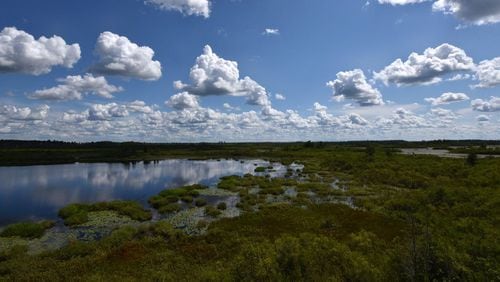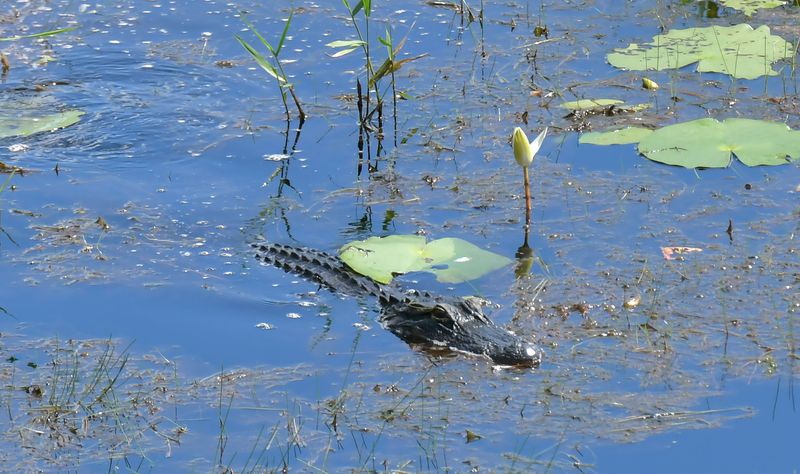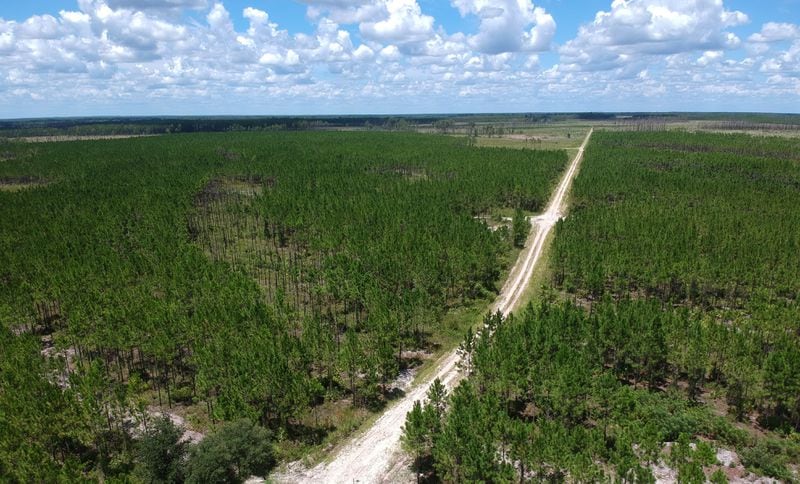A determination by the U.S. Army Corps of Engineers last year dramatically changed the trajectory of a proposed titanium mine near the Okefenokee Swamp.
Based on a Trump administration rule that removed federal protections from many wetlands and streams, the Corps decided that the project would no longer be subject to its oversight. The move placed the fate of the mine solely in the hands of Georgia’s Environmental Protection Division (EPD).
A judge struck down the Trump-era rule in August, and environmental groups were optimistic that the mining project would still have to clear a federal assessment.
But more than two months later, that has not happened, and it’s unclear if it will.
Credit: Hyosub Shin / Hyosub.Shin@ajc.com
Credit: Hyosub Shin / Hyosub.Shin@ajc.com
The mining permits are being sought by Birmingham, Alabama-based Twin Pines Minerals, LLC, which aims to extract titanium on 740 acres located just 2.9 miles from the southeastern edge of the Okefenokee.
Attorneys from groups opposed to the mine say they are holding out hope that the EPA will take a fresh look at the project because of the significant risk they say it poses to the swamp.
“We think that since the (Trump-era) rule was invalidated, that jurisdictional determinations are also not valid,” said Bill Sapp, a senior attorney with the Southern Environmental Law Center. “Certainly, we hope that they will reach a decision that will allow the federal government to play a role in this permitting.”
On Thursday, the EPA published a proposed rule that — if finalized — would reinstate many of the protections that were rolled back by the Trump rule. But finalizing the regulations could take many months and experts say it’s unclear what impact it will have on the mine in the short term.
In an emailed statement, EPA spokesperson Dawn Harris-Young said that the agency continues to work on new regulations to replace the vacated Trump-era wetlands rule, but did not commit to any steps that could immediately affect the future of the Twin Pines project.
“The agencies continue to review the order and consider next steps, including looking at impacts on individual projects,” Harris-Young said.
Scientists who spoke with the AJC say that the risks of mining near the refuge are significant, while Twin Pines insists its models show it would have negligible impacts.
The refuge is home to thousands of species including 40 species of mammals, more than 200 species of birds, 50 species of reptiles, and more than 600 plant species, including many that are federally protected, according to the Okefenokee Protection Alliance. The swamp also holds an estimated 95 million tons of carbon in vast peat deposits, keeping huge amounts of heat-trapping carbon dioxide from escaping into the atmosphere.
If authorized, the mine would sift for titanium on top of an ancient inland sand dune complex called Trail Ridge, which runs north-south from southeastern Georgia into northeastern Florida. The ridge is rich in heavy minerals and the Florida portion has been mined since the 1940s.
Credit: HYOSUB SHIN / AJC
Credit: HYOSUB SHIN / AJC
But further north, the ridge also serves as a natural levee that keeps the Okefenokee filled with water, according to Todd Rasmussen, a professor of hydrology and water resources at the University of Georgia.
Rasmussen says more studies are needed to understand how the mine could affect Trail Ridge’s function as a natural dam, He also says he has concerns that groundwater pumping by the mine could lower water levels in the swamp.
“Say you have heavy rains in the swamp and water levels are full ... you may not even notice that change,” Rasmussen said. “But say there’s a drought and water levels are low, then you could certainly imagine an impact that would be much greater.”
In an emailed response, Twin Pines president Steve Ingle called claims that the mine could drain the swamp “simply wrong.”
“Two independent models were performed to evaluate potential impacts to the swamp, and both indicated negligible impact,” Ingle said.
In the past, Rasmussen said, this kind of project would have gone through a comprehensive environmental assessment from the federal government.
“I’m just recommending that additional scientific and technical studies be performed to evaluate this,” Rasmussen said. “Currently, the mine is providing information but it’s like one hand clapping — you need somebody else to look over the information and evaluate its rigor and comprehensiveness.”
Meanwhile, the fight over the proposed mine has continued to simmer.
In April, Georgia’s U.S. Senators Jon Ossoff and Raphael Warnock sent a letter to the US Fish and Wildlife Service urging the agency to assist the Georgia EPD in evaluating Twin Pines’ applications. And last month, dozens of faith leaders signed onto a letter calling on Governor Kemp, Charlton County’s commissioners, and Ossoff and Warnock to put a halt to the mine’s permits.
Twin Pines has touted the economic benefits it says the mine could bring to Charlton County, where the median annual household income is just over $41,961 — well below the statewide median of $58,700, according to US Census Bureau data. The company’s website says the project will employ around 400 full-time workers, with annual salary and benefits packages averaging around $60,000.
Recreation in the Okefenokee itself supports 753 jobs and pumps nearly $65 million in consumer spending into the local economy, according to the US Fish and Wildlife Service.
In 2019, the Charlton County Board of Commissioner’s passed a resolution backing the mine project because of the economic benefits.
But some who live near the mine site have different views.
Rev. Antwon Nixon is the pastor of Carmel Baptist Church located in Folkston along the Okefenokee’s eastern edge, and was one of the signatories on the recent letter sent to state and local leaders opposing the mine. Nixon was born and raised in the area and grew up visiting the swamp.
He says he understands the appeal that mining jobs have for some in the community. But he worries that the long-term risks outweigh the benefits of a potential influx of money.
“What we cannot do as a people is compromise our safety and what’s right for something that might help our financial situation,” Nixon said.
In the meantime, Twin Pines is moving ahead in pursuit of the permits it needs from the state.
In October, the Georgia EPD sent a letter to Twin Pines asking for more details on how the company plans to store water used for mining in ponds and keep runoff from escaping into surrounding areas. They also asked for more information about how those containment ponds will be closed down when mining is complete.
Ingle said that Twin Pines’ could submit answers to those questions as soon as this week.
Possible Twin Pines mine approval timeline
Once the Georgia EPD is satisfied with Twin Pines’ mining plans, here’s a rough timeline of what the rest of the permitting process could look like, according to Jamie Lancaster, manager of the agency’s surface mining unit:
- A public hearing will be held to share updates on the project and a 60-day comment period will start.
- After the comment period has ended, Georgia EPD could issue draft permits.
- Another public hearing would be held and another 60-day comment period would begin.
- At the end of the comment period, Georgia EPD could issue final permits.
About the Author









